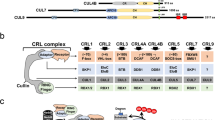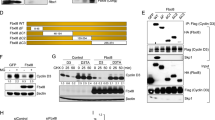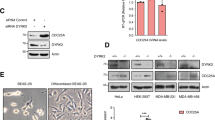Abstract
Degradation of the mammalian cyclin-dependent kinase (CDK) inhibitor p27 is required for the cellular transition from quiescence to the proliferative state. The ubiquitination and subsequent degradation of p27 depend on its phosphorylation by cyclin–CDK complexes. However, the ubiquitin–protein ligase necessary for p27 ubiquitination has not been identified. Here we show that the F-box protein SKP2 specifically recognizes p27 in a phosphorylation-dependent manner that is characteristic of an F-box-protein–substrate interaction. Furthermore, both in vivo and in vitro, SKP2 is a rate-limiting component of the machinery that ubiquitinates and degrades phosphorylated p27. Thus, p27 degradation is subject to dual control by the accumulation of both SKP2 and cyclins following mitogenic stimulation.
This is a preview of subscription content, access via your institution
Access options
Subscribe to this journal
Receive 12 print issues and online access
$209.00 per year
only $17.42 per issue
Buy this article
- Purchase on SpringerLink
- Instant access to full article PDF
Prices may be subject to local taxes which are calculated during checkout







Similar content being viewed by others
References
Sherr, C. & Roberts, J. Cdk inhibitors: positive and negative regulators of G1-phase progression. Genes Dev. 13, 1501–1514 (1999).
Elledge, S. J., Winston, J. & Harper, J. W. A question of balance: the roles of cyclin kinase inhibitors in development and tumorigenesis. Trends Cell Biol. 6, 388–392 ( 1996).
Sheaff, R. J. & Roberts, J. M. in Cell Cycle Control, Results Probl. Cell Differ. Vol. 22 (ed. Pagano, M.) 1– 34 (Springer, New York, 1998).
Hershko, A. Roles of ubiquitin-mediated proteolysis in cell cycle control. Curr. Opin. Cell Biol. 9, 788–799 (1997).
Pagano, M. Regulation of cell cycle regulatory proteins by the ubiquitin pathway. FASEB J. 11, 1067–1075 ( 1997).
Patton, E., Willems, A. & Tyers, M. Combinatorial control in ubiquitin-dependent proteolysis: don"t Skp the F-box hypothesis. Trends Genet. 14, 6–14 (1998).
Loda, M. et al. Increased proteasome-dependent degradation of the cyclin-dependent kinase inhibitor p27 in aggressive colorectal carcinomas. Nature Med. 3, 231–234 ( 1997).
Esposito, V. et al. Prognostic role of the cell cycle inhibitor p27 in non small cell lung cancer. Cancer Res. 57, 3381– 3385 (1997).
Mayor, S. Protein marker linked with poor cancer outcome. Br. Med. J. 314, 323 (1997).
Steeg, P. & Abrams, J. Cancer prognostic: past, present and p27. Nature Med. 3, 152– 154 (1997).
Ciechanover, A. The ubiquitin-proteasome pathway: on protein death and cell life. EMBO J. 17, 7151–7160 ( 1998).
Budel, L. et al. Characterization of p21, p27, p53 and E2F-1 cell cycle regulators in mantle cell lymphoma: increased ubiquitin-proteasome mediated degradation of p27. Blood (in the press).
Piva, R. et al. Increased proteasome-dependent degradation of p27 in malignant gliomas. J. Neuropathol. Exp. Neurol. (in the press).
Pagano, M. et al. Role of the ubiquitin-proteasome pathway in regulating abundance of the cyclin-dependent kinase inhibitor p27. Science 269, 682–685 (1995).
Montagnoli, A. et al. Ubiquitination of p27 is regulated by Cdk-dependent phosphorylation and trimeric complex formation. Genes Dev. 13, 1181–1189 (1999).
Shirane, M. et al. Down-regulation of p27 by two mechanisms, ubiquitin-mediated degradation and proteolytic processing. J. Biol Chem. 274, 13886–13893 (1999).
Muller, D. et al. Cdk2-dependent phosphorylation of p27 facilitates its Myc-induced release from cyclin E/cdk2 complexes. Oncogene 15, 2561–2576 (1997).
Sheaff, R., Groudine, M., Gordon, M., Roberts, J. & Clurman, B. Cyclin E-Cdk2 is a regulator of p27Kip1. Genes Dev. 11, 1464–1478 (1997).
Vlach, J., Hennecke, S. & Amati, B. Phosphorylation-dependent of the cyclin-dependent kinase inhibitor p27Kip1. EMBO J. 16, 5334– 5344 (1997).
Hershko, A. & Ciechanover, A. The ubiquitin system. Annu. Rev. Biochem. 67, 425–479 (1998).
Koepp, D., Harper, J. W. & Elledge, S. J. How the cyclin became a cyclin: regulated proteolysis in the cell cycle. Cell 97, 431– 433 (1999).
Latres, E., Chiaur, D. S. & Pagano, M. The human F-box protein β-Trcp associates with the Cul1/Skp1 complex and regulates the stability of β-catenin. Oncogene 18, 849–855 ( 1999).
Winston, J. T. et al. The SCFβ-TRCP ubiquitin ligase complex associates specifically with phosphorylated destruction motifs in IκBα and β-catenin and stimulates IκBα ubiquitination in vitro. Genes Dev. 13, 270–283 ( 1999).
Laney, J. & Hochstrasser, M. Substrates targeting in the system. Cell 97, 427–430 (1999).
Zhang, H., Kobayashi, R., Galaktionov, K. & Beach, D. p19Skp-1 and p45Skp-2 are essential elements of the cyclin A-Cdk2 S phase kinase. Cell 82, 915–925 (1995).
Yaron, A. et al. Identification of the receptor component of the IkappaBalpha-ubiquitin ligase. Nature 396, 590– 594 (1998).
Lisztwan, J. et al. Association of human CUL-1 and ubiquitin-conjugating enzyme CDC34 with the F-box protein p45(SKP2): evidence for evolutionary conservation in the subunit composition of the CDC34-SCF pathway. EMBO J. 17, 368–383 (1998).
Michel, J. J. & Xiong, Y. Human Cul1, but not other cullin family members, selectively interacts with SKP1 to form a complex with SKP2 and cyclin A. Cell Growth Differ. 9, 435– 449 (1998).
Hart, M. et al. The F-box protein β-TrCP associates with phosphorylated beta-catenin and regulates its activity in the cell. Curr. Biol. 9, 207–210 (1999).
Spencer, E., Jiang, J. & Chen, Z. J. Signal-induced ubiquitination of IB by the F-box protein Slimb/β-TrCP. Genes Dev. 13, 284– 294 (1999).
Feldman, R. M., Correll, C. C., Kaplan, K. B. & Deshaies, R. J. A complex of Cdc4p, Skp1p, and Cdc53p/Cullin catalyzes ubiquitination of the phosphorylated Cdk inhibitor Sic1p. Cell 91, 221–230 (1997).
Kominami, K. & Toda, T. Fission yeast WD-repeat protein pop1 regulates genome ploidy through ubiquitin-proteasome-mediated degradation of the CDK inhibitor Rum1 and the S-phase initiator Cdc18. Genes Dev. 11, 1548–1560 ( 1997).
Skowyra, D., Craig, K. L., Tyers, M., Elledge, S. J. & Harper, J. W. F-box proteins are receptors that recruit phosphorylated substrates to the SCF ubiquitin-ligase complex. Cell 91, 209–219 (1997).
Kominami, K., Ochotorena, I. & Toda, T. Two F-box/WD-repeat proteins Pop1 and Pop2 form hetero- and homo- complexes together with cullin-1 in the fission yeast SCF (Skp1-Cullin1-F-box) ubiquitin ligase. Genes Cells 3, 721– 735 (1998).
Jallepalli, P. V., Tien, D. & Kelly, T. J. sud1(+) targets cyclin-dependent kinase-phosphorylated Cdc18 and Rum1 proteins for degradation and stops unwanted diploidization in fission yeast. Proc. Natl Acad. Sci. USA 95, 8159–8164 (1998).
Maekawa, H., Kitamura, K. & Shimoda, C. The Ste16 WD-repeat protein regulates cell-cycle progression under starvation through the Rum1 protein in Schizosaccharomyces pombe. Curr. Genet. 33, 29– 37 (1998).
Tomoda, K., Kubota, Y. & Kato, J. Degradation of the cyclin-dependent-kinase inhibitor p27 is instigated by Jab1. Nature 398, 160– 164 (1999).
Yu, Z. K., Gervais, J. & Zhang, H. Human Cul1 associates with the Skp1/Skp2 complex and regulates p21(CIP1/WAF1) and cyclin D proteins. Proc. Natl Acad. Sci. USA 95, 11324–11329 (1998).
Marti, A., Wirbelauer, C., Scheffner, M. & Krek, W. Interaction between ubiquitin–protein ligase SCFSKP2 and E2F-1 underlies the regulation of E2F-1 degradation. Nature Cell Biol. 1, 14–19 (1999).
Pagano, M. et al. Regulation of the human cell cycle by the Cdk2 protein kinase . J. Cell Biol. 121, 101– 111 (1993).
Pagano, M., Pepperkok, R., Verde, F., Ansorge, W. & Draetta, G. Cyclin A is required at two points in the human cell cycle. EMBO J. 11, 761– 771 (1992).
O’Connor, P. & Jackman, J. in Cell Cycle: Materials and Methods (ed. Pagano, M.) 63–74 (Springer, New York, 1995).
Pagano, M. in Cell Cycle: Materials and Methods (ed. Pagano, M.) 271– 280 (Springer, New York, 1995).
Harlow, E. & Lane, D. in Using Antibodies. A Laboratory Manual (eds Harlow, E. & Lane, D.) 187–233 (Cold Spring Harb. Lab. Press, Cold Spring Harbor, 1998).
Faha, B., Harlow, E. & Lees, E. The adenovirus E1A-associated kinase consists of cyclin E-p33cdk2 and Cyclin A-p33cdk2. J.Virol. 67, 2456–2465 (1993).
Pagano, M., Draetta, G. & Jansen-Dürr, P. Association of cdk2 kinase with the transcription factor E2F during S phase. Science 255, 1144– 1147 (1992).
Desai, D., Gu, Y. & Morgan, D. O. Activation of human cyclin-dependent kinase in vitro. Mol. Biol. Cell 3, 571– 582 (1992).
Hochstrasser, M. There’s the rub: a novel ubiquitin-like modification linked to cell cycle regulation. Genes Dev. 12, 901– 907 (1998).
Acknowledgements
We thank G. Draetta, M. Garabedian, E. Harlow, A. Koff, E. Lees, D. Morgan, A. Pause, Y. Xiong and H. Zhang for reagents; M. Chao, J. Lukas and L. Yamasaki for critically reading the manuscript; and E. Latres and other members of M.P.’s laboratory for their contribution to this work. M.P. thanks L. Yamasaki and T.B. Balduur for their continuous support. A.H. is supported in part by grants from the Israel Ministry of Science and The Council for Tobacco Research, USA, and by a Human Frontier Science Program Organization (HFSPO) grant (RG0229); M.P. is supported by an HFSPO grant (RG0229) and by NIH RO1 grants CA76584 and GM57587.
Correspondence and requests for materials should be addressed to M.P.
Author information
Authors and Affiliations
Corresponding author
Rights and permissions
About this article
Cite this article
Carrano, A., Eytan, E., Hershko, A. et al. SKP2 is required for ubiquitin-mediated degradation of the CDK inhibitor p27. Nat Cell Biol 1, 193–199 (1999). https://doi.org/10.1038/12013
Received:
Revised:
Accepted:
Published:
Issue Date:
DOI: https://doi.org/10.1038/12013



